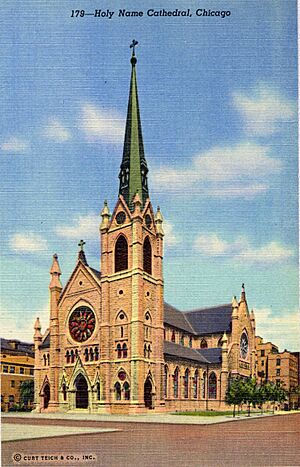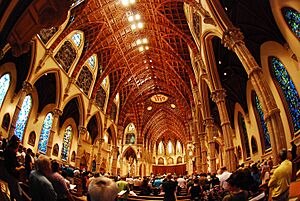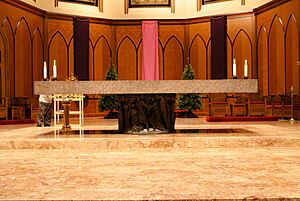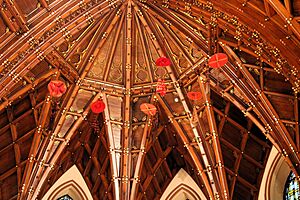Holy Name Cathedral (Chicago) facts for kids
Quick facts for kids Holy Name Cathedral |
|
|---|---|

View from State Street
|
|
| Location | 730 North Wabash Avenue Chicago, Illinois |
| Country | United States |
| Denomination | Roman Catholic |
| History | |
| Status | Cathedral |
| Founded | 1843 (parish) |
| Dedicated | November 21, 1875 by Bishop Thomas Foley |
| Architecture | |
| Functional status | Active |
| Heritage designation | NRHP |
| Designated | 2000 |
| Architect(s) | Patrick Keely et al. |
| Style | Gothic Revival |
| Groundbreaking | July 19, 1874 |
| Administration | |
| Parish | Holy Name |
| Archdiocese | Chicago |
| Province | Chicago |
Holy Name Cathedral is a very important church in Chicago, Illinois. It's the main church for the Roman Catholic Archdiocese of Chicago, which is one of the biggest Catholic groups in the United States. The church is where the current Archbishop of Chicago, Cardinal Blase J. Cupich, has his official seat.
The cathedral was opened on November 21, 1875. It was built to replace two older churches, the Cathedral of Saint Mary and the Church of the Holy Name. Both of these churches were destroyed in the terrible Great Chicago Fire of 1871. In 2009, during some repairs, a fire caused a lot of damage to the roof and inside of the church. But the damage was fixed, and the cathedral reopened later that same year.
Contents
History of Holy Name Cathedral
The Great Chicago Fire of 1871
When the Catholic Diocese of Chicago was first started in 1843, Bishop William Quarter led his church from the Cathedral of Saint Mary. A few years later, in 1851, a large brick church called the Church of the Holy Name was being built. Its first stone was placed in 1852.
However, in October 1871, both churches were destroyed by the Great Chicago Fire. This huge fire burned down much of the city. The pastor, John McMullen, traveled around the country to raise money. He wanted to rebuild the churches and help the many people in Chicago who lost their homes. For a while, Chicago's Catholics had to worship in a damaged house, which they called the shanty cathedral.
Building the New Cathedral
In 1874, an architect named Patrick Charles Keely was chosen to design the new cathedral for Chicago. He also designed another church called St. Stanislaus Kostka Church. On July 19, 1874, the first stone for the new cathedral was laid.
Just over a year later, on November 21, 1875, Bishop Thomas Foley officially opened the church. He named it the Cathedral of the Holy Name. In 1880, the Diocese of Chicago became the Archdiocese of Chicago. This meant Holy Name Cathedral became the most important church for several other Catholic areas in the Midwest United States.
Early Changes and Repairs
In 1888, people noticed that the cathedral was sinking a little on one side. Because of this, the archbishop decided to start the first big renovation projects. By 1915, Holy Name Cathedral was made stable and saved from sinking further. It was also made longer by about 4.6 meters (15 feet). This was done to make space for the growing number of Catholic people.
In that same year, James Edward Quigley, who was the Archbishop of Chicago, passed away. The first major church service held in the newly repaired cathedral was the funeral for the late archbishop.
Cardinal George Mundelein
In 1924, Archbishop George Mundelein was given a special honor by the pope. He became a cardinal. When he came back from the Vatican, a huge celebration greeted him at Holy Name Cathedral. Over 80,000 Catholics joined a procession to welcome the new cardinal.
Cardinal Mundelein also helped Chicago become the host city for a big event called the 28th International Eucharistic Congress in 1926. The opening church service for this event was held at the cathedral.
When Cardinal Mundelein passed away suddenly in October 1939, the city quickly paved State Street. This was because a subway was being built there, and they needed to make way for the many people expected to come. Over a million people came to pay their respects as Cardinal Mundelein lay in state inside Holy Name Cathedral.
Changes After Vatican II
After the Second Vatican Council ended in the 1960s, Holy Name Cathedral began a large and somewhat debated renovation project. The goal was to change the inside of the cathedral. From Easter 1968 to 1969, the cathedral was closed. Church services were held in other places, like a nearby school gym.
During this time, all the stained glass, oil paintings, and marble statues were taken out of the cathedral. The inside became much simpler. A huge, six-ton granite altar and a special crucifix became the main features. On Christmas Eve of 1969, Holy Name Cathedral reopened its doors.
Papal Visit in 1979
In October 1979, Pope John Paul II made history. He became the first Pope to visit Holy Name Cathedral. He held a prayer service with Chicago's bishops. There was also a concert featuring the famous singer Luciano Pavarotti and the Chicago Symphony Orchestra inside the cathedral. The people there also prayed the Our Father in Latin, as the Pope requested.
Recent Repairs and Fire
Holy Name Cathedral needed major emergency repairs from February to August 2008. A piece of the fancy wooden ceiling fell down on February 10, 2008. After more pieces fell, the cathedral was closed for safety. It reopened for weekend services in late August 2008 and fully reopened in November 2008.
It closed again after a big fire on February 4, 2009. The fire started in the attic, where workers were finishing the repairs from the year before. It was caused by a faulty ice melting system on the roof. The church suffered a lot of water damage. Firefighters bravely entered the burning attic without their helmets and oxygen tanks. Their quick actions saved the building, as fires in such old buildings often lead to total loss. The cathedral reopened in August 2009.
Architecture and Design
Holy Name Cathedral was built in the Gothic Revival style. This style looks like old European churches. The building is about 71 meters (233 feet) long and 38 meters (126 feet) wide. It can seat 1,110 people. The ceiling is about 21 meters (70 feet) high, and a tall spire reaches about 64 meters (210 feet) into the sky. The design of the cathedral is meant to make visitors feel like they are inside a giant "tree of life."
Bronze Entrance Doors
The first thing visitors see are huge bronze doors. They were designed by Albert J. Friscia. Each door weighs about 544 kilograms (1200 pounds). The doors continue the "Tree of Life" theme with detailed designs that make them look like large wooden planks. A special system allows them to be opened easily with just a touch. Beyond these doors is a glass-enclosed entrance area.
The Resurrection Crucifix
Once inside, the most striking feature is the Resurrection Crucifix. This large sculpture by Ivo Demetz hangs above the altar. Along the walls of the main part of the church are the Stations of the Cross. These artworks by Goffredo Verginelli show scenes from the story of Jesus's suffering, death, and rising again. They are made of bronze and framed in red marble.
Ambo of the Evangelists
Many bronze sculptures are found throughout the church. One of the largest is the Ambo of the Evangelists by Eugenio de Courten. An ambo is a special stand where parts of the Bible are read during church services. This bronze sculpture shows the writers of the Gospels with their symbols:
Ambo of the Epistle Writers
Also by de Courten is another ambo, the Ambo of the Epistle Writers. This bronze sculpture shows the writers of the letters (epistles) to the early Christian communities:
This ambo is used by readers and singers during Sunday services and other special church events.
The Cathedral Altar
The main altar's top, called the mensa, is made from a single piece of red-black granite. It weighs six tons. The base of the altar has bronze carvings. These carvings show scenes from the Old Testament about offerings and preparations. They include Abel's offering, Melchizedek giving bread and wine, Abraham almost sacrificing his son Isaac, and the Prophet Elijah receiving food from an angel. The altar also holds special items called relics. These are small pieces from the bodies of Saint John the Apostle and Saint Timothy.
The Bishop's Chair
A cathedra is a bishop's special chair. This chair is what makes a church a cathedral. From this chair, the Archbishop of Chicago leads the Catholic community. Unlike many other Catholic cathedras, the Cathedra of the See of Chicago is simple. Its back has three panels showing the first Christian teachers: Jesus in the middle, Saint Peter on his right, and Saint Paul on his left.
Sanctuary Panels of the Holy Name
Above the bishop's chair are the Sanctuary Panels of the Holy Name. These are five bronze panels by Attilio Selva. They represent the Holy Name of Jesus, which is where the church gets its name.
- The first panel shows Simeon looking at the Infant Savior as Mary brings him to the Temple.
- The second panel shows the Mystery of the Trinity and an angel bringing Christ's symbol to earth.
- The third panel shows the Risen Christ being announced as Lord.
- The fourth panel shows the Presentation of Jesus in the Temple, where Mary and Joseph bring the child for naming.
- The last panel shows the Priesthood of Jesus, with Christ offering a special cup to everyone.
Pipe Organs
The cathedral has two beautiful pipe organs. A large organ with 71 stops and 4 keyboards is in the west end gallery. It was built by Flentrop Orgelbouw in the Netherlands. A smaller organ with 19 stops and 2 keyboards is in the south chancel. It was made by Casavant Frères in Quebec, Canada.
Galeri of the Cardinals
Holy Name Cathedral has a special tradition. When a cardinal passes away, their galero (a wide-brimmed hat with tassels) is hung high above the bishop's chair. It stays there until it turns to dust. This symbolizes that all earthly glory eventually fades away. You can see the galeri of cardinals George Mundelein, Samuel Stritch, Albert Gregory Meyer, John Cody, Joseph Bernardin, and Francis George hanging there.
Interesting Facts
A stone at the corner of the church still shows faint marks from bullets. These marks are from October 11, 1926, when a gang member named Hymie Weiss was killed near the church.
175th Anniversary Celebration
In 2024, Holy Name Cathedral celebrated its 175th Anniversary. They held two special church services on November 18 and 24, 2024. They also announced a year-long celebration of this important event. The Chicago City Council even declared November 18, 2024, to be Holy Name Cathedral Day.
Several events were part of the celebration:
- On December 13, 2024, the Fifth Annual Rector's Christmas Concert was held as a free gift to the church community.
- On January 5, 2025, the "Faith and Fitness" series presented a free discussion panel about New Year's resolutions.
- In Winter 2025, a new Mural was created and installed in the Cathedral Courtyard. An unveiling event for it was held in May 2025.
- On June 8, 2025, a "Revival Celebration" called 'The Road to Emmaus' took place. It focused on the Christian journey.
- On June 27, 2025, an artist and retired priest, Fr. Anthony J. Brankin, created a bronze sculpture of the Sacred Heart. It was dedicated in honor of Pope Francis's special letter, Dilexit Nos.
See also
 In Spanish: Catedral del Santo Nombre (Chicago) para niños
In Spanish: Catedral del Santo Nombre (Chicago) para niños






